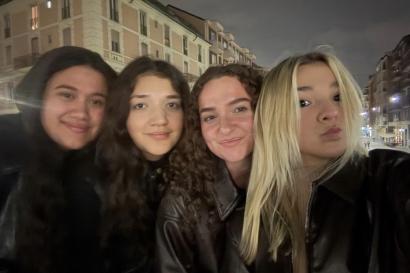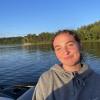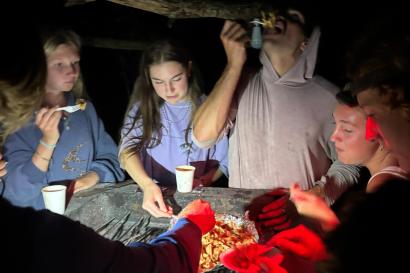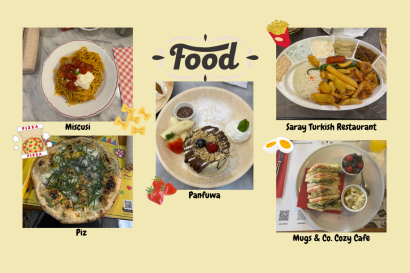We spent our second day on San Cristóbal taking a field trip to three local spots along a road: El Junco Lake, La Galapaguera de Cerro Colorado, and Puerto Chino.
Our first stop was to El Junco Lake in the “highlands” 2,400 feet above sea level. (Compared to mainland Ecuador where highlands are 15,000 feet high and biodiversity means the most biodiverse spot on Earth, everything on the Galápagos sounds a bit underwhelming.) But my skepticism disappeared as soon as we got off the bus and saw this:

The native vegetation is dominated by Miconia robinsoniana, the leathery green-red bushes peeking through the fog. Recent invasions of raspberry plants and guava trees had almost wiped out the miconia, but an intense weed-pulling campaign by the National Park Service gave it a second chance. The place looks almost back to normal now, we were told, but guavas and raspberries are recolonizing as fast as they can. We ate a few of each to do our part.

A guava tree behind a raspberry bush, both with unripe fruits.
We slipped and clawed our way up an inexplicably slippery hill to reach the lake, the only permanent freshwater in the Galápagos. The lake has been here for 50,000 years, and in past centuries it was the only place in the South Pacific for sailors to fill up their casks. Apparently, it’s also the frigatebirds’ bathtub.
Magnificent frigatebirds are so well adapted to flying, they’ve lost the ability to walk or swim, instead spending their entire life on the wing. Oddly, their feathers aren’t salt-proof, so frigatebirds can only bathe in freshwater!
We took a short hike around the rim of the lake, which gives you an idea of its size. (Our guide told us to be generous with the Galapagueño definition of “lake”, since it doesn’t sound quite as impressive to call El Junco “the only freshwater pond in the Galápagos.”)

My feet at the edge of El Junco.

A San Cristóbal mockingbird.

We were lucky to see the fog lift, exposing the lake for a fleeting moment.
Next stop: La Galapaguera!

The giant tortoise daycare, where babies live for their first ten years.

Three babies from the 2010-2011 batch.

My new best friend, an adolescent San Cristóbal tortoise.

A female small ground finch, like the ones famously studied by Peter and Rosemary Grant.

A yellow warbler at La Galapaguera.
Each island has its own species of giant tortoise. Actually, each volcano often has its own: the island of Isabela has five species for its five volcanoes. San Cristóbal used to have two species, one from the northeast and one from the south, but the southern species went extinct due to collection by whalers and pirates. Because the giant tortoises’ nests are pillaged by invasive rats, cats, goats, and fire ants, the National Park Service breeds tortoises in captivity and raises the babies until they are large enough to fend for themselves. Overall this program has been a conservation success story: the first released tortoises have been recorded breeding in the wild. Some species, like that of Lonesome George, have already been lost.
After our time with the tortoises, we trundled on to our last stop, Puerto Chino. While most of the class went swimming, I went exploring with our guide, Fabrizio, and professor, Carlos. Over the beach and through the sea lions, to the lava promontory we go!

Galápagos sea lions on the beach.

A hidden view from the lava promontory.

A giant Opuntia cactus tree.

A pair of blue-footed boobies. The female, with more dilated pupils, is in front.

I watched this brown pelican preen for half an hour.
A bunch of us are heading back to Puerto Chino tomorrow in the back of a pickup truck to practice surfing and check on our sea lion, booby, pelican, sea turtle, lava lizard, and cactus friends!
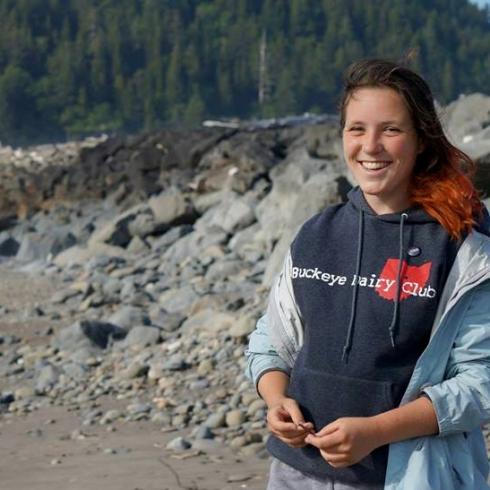
Nina Finley
<p><span style="color: rgb(29, 29, 29); font-family: Arial, Verdana, sans-serif; font-size: 12px; line-height: normal; background-color: rgb(237, 237, 237);">Nina Finley is a sophomore at The Ohio State University. She ventured to the Midwest from her hometown of Seattle, Washington to major in Animal Sciences and Evolution & Ecology. She would like to become a livestock vet or marine biologist. When she’s not studying, Nina loves to play ultimate frisbee, watch birds and raise meat rabbits. She’s passionate about agriculture, nature and Spanish, all of which she hopes to explore in Ecuador. Join the journey as Nina traces Darwin’s path and explores the natural wonders of the Galapagos Islands!</span></p>



